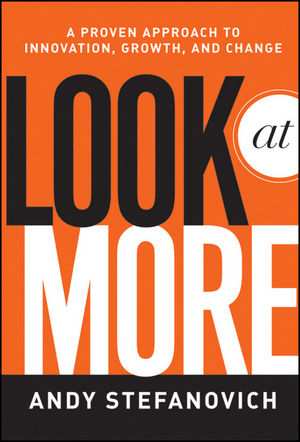Recommended Resources – Look At More
Look at More: A Proven Approach to Innovation, Growth, and Change
by Andy Stefanovich
About the Book
Look at More by Andy Stefanovich details a framework for unleashing an organization’s creativity to develop new products, build brands and audiences, and grow market share. Andy’s framework specifically targets the liberation of the ‘5Ms’ of innovation:
- Mood: attitudes, feelings, and emotions creating the context for creativity and innovation
- Mindset: intellectual foundation of creativity, the baseline capacity each of us has for getting inspired, staying excited, and thinking differently
- Mechanisms: tools and processes of creativity; helping individuals incorporate inspiration into the way they work and fostering innovative behaviors
- Measurement: qualitative and quantitative assessments providing employees with direction and feedback
- Momentum: active reinforcement of the creative behaviors supporting innovation
Benefits of Using this Book
StrategyDriven Contributors like Look At More for its immediately actionable framework that encourages and reinforces the behaviors unleashing an organization’s innovative creativity. Additionally, we appreciate the detailed examples Andy provides from his experience implementing the framework at world renown corporations.
Besides driving innovation, we believe organization implementing Andy’s methods will also experience an increased level of employee engagement that, in our experience, significantly enhances productivity and the bottom line.
Look At More prescribes an immediately actionable method for unleashing employee creativity to support achievement of organizational goals; making it a StrategyDriven recommended read.


 Helanie (pronounced yeh-LAH-nee) Scott has driven stunning leadership and cultural transformations for an impressive list of organizations including: Dr. Pepper, Reuters, Fluor, Ericsson, PepsiCo and more.
Helanie (pronounced yeh-LAH-nee) Scott has driven stunning leadership and cultural transformations for an impressive list of organizations including: Dr. Pepper, Reuters, Fluor, Ericsson, PepsiCo and more. Michael Feuer cofounded OfficeMax in 1988 starting with one store and $20,000 of his own money, a partner, and a small group of investors. As CEO, he grew it to more than 1,000 stores worldwide with annual sales topping $5 billion. He is also CEO of Max-Ventures, a venture capital and retail consulting firm, and founder and CEO of Max-Wellness, a comprehensive health and wellness retail chain that launched in 2010. After opening initial laboratory test stores in Florida and Ohio, a national roll-out is now underway. To read Michael Feuer’s complete biography,
Michael Feuer cofounded OfficeMax in 1988 starting with one store and $20,000 of his own money, a partner, and a small group of investors. As CEO, he grew it to more than 1,000 stores worldwide with annual sales topping $5 billion. He is also CEO of Max-Ventures, a venture capital and retail consulting firm, and founder and CEO of Max-Wellness, a comprehensive health and wellness retail chain that launched in 2010. After opening initial laboratory test stores in Florida and Ohio, a national roll-out is now underway. To read Michael Feuer’s complete biography,  Dustin S. Klein, contributor and editor of The Benevolent Dictator, is the publisher and executive editor of Smart Business Network, publishers of Smart Business, the nation’s second-largest chain of regional business publications. He has interviewed thousands of senior executives and civic leaders across America. He is a regular presenter on business-related issues for public and private business audiences and is a frequent guest on television, radio, and Internet programs. To read Dustin Klein’s complete biography,
Dustin S. Klein, contributor and editor of The Benevolent Dictator, is the publisher and executive editor of Smart Business Network, publishers of Smart Business, the nation’s second-largest chain of regional business publications. He has interviewed thousands of senior executives and civic leaders across America. He is a regular presenter on business-related issues for public and private business audiences and is a frequent guest on television, radio, and Internet programs. To read Dustin Klein’s complete biography,  John Cioffi received his first business education in his family’s restaurant and lodging business. He later held executive positions in several companies, ranging from start-ups to a Fortune 100. He has been a business coach for more than 15 years, is a frequent business speaker, and is a partner in GoalMakers Management Consultants. He received a BA from Colby College, a master’s degree from Dartmouth, and an MBA from Wharton.
John Cioffi received his first business education in his family’s restaurant and lodging business. He later held executive positions in several companies, ranging from start-ups to a Fortune 100. He has been a business coach for more than 15 years, is a frequent business speaker, and is a partner in GoalMakers Management Consultants. He received a BA from Colby College, a master’s degree from Dartmouth, and an MBA from Wharton.